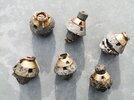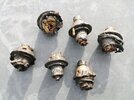panzergraf
Member
Hi guys, after years of just reading I'm going into action 
My son and I are collecting the remains of the battlefields of WW I - but no, we don't rob historical places with detectors. We just collect the clearly as inert identifiable remains dug out by farmers in the fields or at their dirt roads.
So recently some fuses found their way to our small collection. And here the problem starts:
Normally I clean the objects coverd with heavy rust with brass wheels or sand-blasting, later or if the pice is not too corroded by using a solution of citric acid in water - I normally prefer the latter, because it is the smoothest way for the material. That works fine for iron or iron and copper as driving bands. Now I got a problem with the fuses made of a mixture of brass and iron. There is an electro-chemical reaction in the brass, dissolving the copper out of the material and creating a copper-overlay over the non-iron parts, while the deoxidation/reduction of the iron seems to be slowed down.
Has somebody an answer for this problem, or am I just overreacting?
Thanks a lot for helping an greetings from Germany!
My son and I are collecting the remains of the battlefields of WW I - but no, we don't rob historical places with detectors. We just collect the clearly as inert identifiable remains dug out by farmers in the fields or at their dirt roads.
So recently some fuses found their way to our small collection. And here the problem starts:
Normally I clean the objects coverd with heavy rust with brass wheels or sand-blasting, later or if the pice is not too corroded by using a solution of citric acid in water - I normally prefer the latter, because it is the smoothest way for the material. That works fine for iron or iron and copper as driving bands. Now I got a problem with the fuses made of a mixture of brass and iron. There is an electro-chemical reaction in the brass, dissolving the copper out of the material and creating a copper-overlay over the non-iron parts, while the deoxidation/reduction of the iron seems to be slowed down.
Has somebody an answer for this problem, or am I just overreacting?
Thanks a lot for helping an greetings from Germany!


